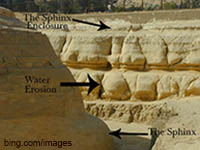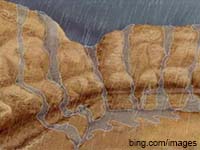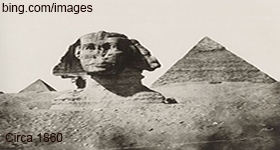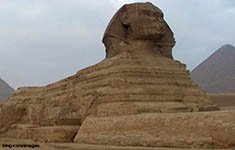In the early 1990's John Anthony West, researcher and amateur archeologist proposed that the Sphinx was far older than previously thought. He proposed that the Sphinx was constructed somewhere between the 7,000 B.C. and 10,000 B.C. West believed that the Sphinx was eroded not only by the wind but also by water. He also noted that while the Sphinx was severely eroded, the nearby pyramids and surrounding temples were not. To back up his theory, he asked geologist Robert Schoch to take a look at the Sphinx. Schoch found that the Sphinx was indeed eroded by water, so this meant that the Sphinx was far older because only rain fall could have produced this kind of water erosion and there hadn't been significant rainfall in Egypt to cause this kind of erosion since 7,000B.C. He then brought his work on the Sphinx to the annual meeting of Geological Society of America where his colleagues found no errors in his work. This finding set off a heated debate between geologists and Egyptologist that is still going on today.
Here are five questions that question the Sphinx's age. 1. Why is there evidence of water erosion on the Sphinx's body and enclosure? 2. Why is the Sphinx so eroded when the pyramids and temples that are supposed to be dated to the same time period are not? 3. Why is the Sphinx so eroded when much of its existence it has been buried and protected by the sand? 4. Why is the head of the Sphinx the least eroded when it’s been above the sand line for most of its existence? 5. Why doesn't the face of the Sphinx match any known pharaoh?
The Orion Theory proposed by Robert Bauval in his book The Orion Theory is based on the position of the Pyramids of Giza and the Sphinx geographically in relation to the three stars of the belt of Orion in the constellation of Orion and their position in the sky in the year 10,500 B.C. Basically the pyramids and the Sphinx, represent heaven on earth and mirror the sky above. Furthermore, the Nile represents the Milky Way while the pyramid of Djedefre in Abu Rauwash represents the star Saiph in the constelation of Orion. Also, the pyramid in Zawyat Al Aryan represents the star Bellatrix in the constellation of Orion while the two pyramids in Dashur represent the Hyades in the constellation of Taurus. Finally, the Sphinx was constructed to represent the constellation of Leo. To learn more about the Sphinx watch the videos provided on the Sphinx and gallery pages. You also may want to read The Orion Theory by Robert Bauval and check out his and Robert Schoch’s sites. Both are provided on the books and links page.



